
Royal Enfield’s J-platform Bikes: Real-world Performance Compared
- Oct 5, 2022
- Views : 27561


Have you ever thought of a Royal Enfield as a beginner bike? Or as a motorcycle that you would recommend someone to learn to ride on? Or to buy as their first bike? Chances are that most of us would answer in the negative. The romantics would say that these highway-loving, mountain-mastering, heavy-duty machines demand a seasoned hand; and the seasoning of said hand is best done on lighter and more forgiving motorcycles. The practical-minded would say REs are simply too big, too heavy, too expensive and too inconvenient for the uninitiated motorcyclist. And, so Royal Enfields have been the coming-of-age motorcycles for the classically minded riders. But RE wants to spur things on and get more, younger, and less scarred (and scared) bums into the Chennai-made saddles. The tool for the job is the Hunter 350. Can it? If so, how?
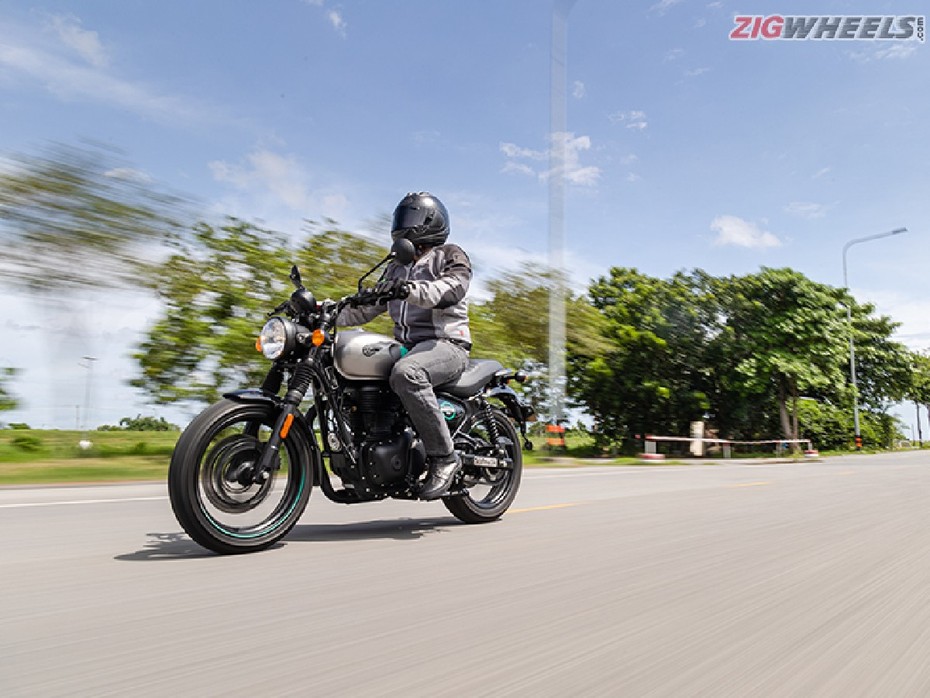
The Hunter 350 is meant to be a modern motorcycle; this means it should be city-friendly, new-rider-friendly and wallet-friendly. A quick glance also confirms that it looks friendly! Its tightly wrapped proportions will invite, not intimidate, newer riders of all sexes. It does look smaller than its siblings, especially when there’s a six-footer astride it. This is because when it comes to dimensions, the Hunter is half a size smaller than the Classic with which it shares its chassis.

The root of this change are the smaller 17” wheels. This is a first of sorts as RE has stayed away from 17” rims because it alters proportions and makes setting the right stance much harder. However, the Hunter looks like an authentic RE, albeit a slightly smaller one. The Hunter looks more accessible and also offers more ease of use as the seat height is lower than the Classic’s; however, the Meteor’s 765mm seat height remains the easy favourite for short riders.
|
Hunter |
Classic |
Meteor |
|
|
Length |
2055 |
2145 |
2140 |
|
Width |
800 |
785 |
845 |
|
Height |
1055 |
1090 |
1140 |
|
Seat Height |
790 |
805 |
765 |
All figures in mm; Measurements without mirrors
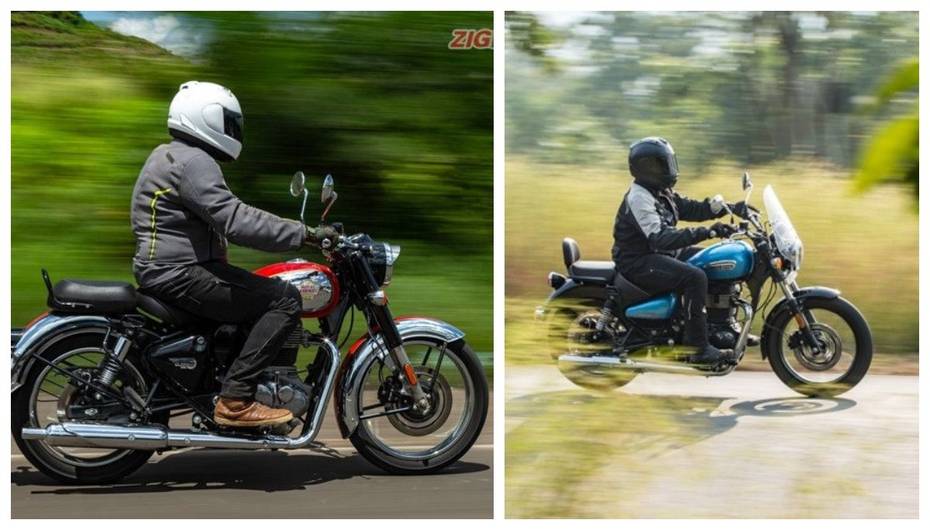
Be they tall or short, experienced or not, RE loyalists or not, riders will be drawn to the Hunter. Even a quick glance sends thoughts and ideas sparking in your head. It has muscular hints to be called the Interceptor 350, aka the baby roadster. It looks timeless enough, especially with its teardrop-shaped tank, that you could call it the modern iteration of the Classic 350. I think calling it a baby Triumph Street Twin and the potential to be a Yamaha XSR155 killer is flattering too. Basically, it packs a lot of appeal and it gets yummier when we talk about the Retro variant.
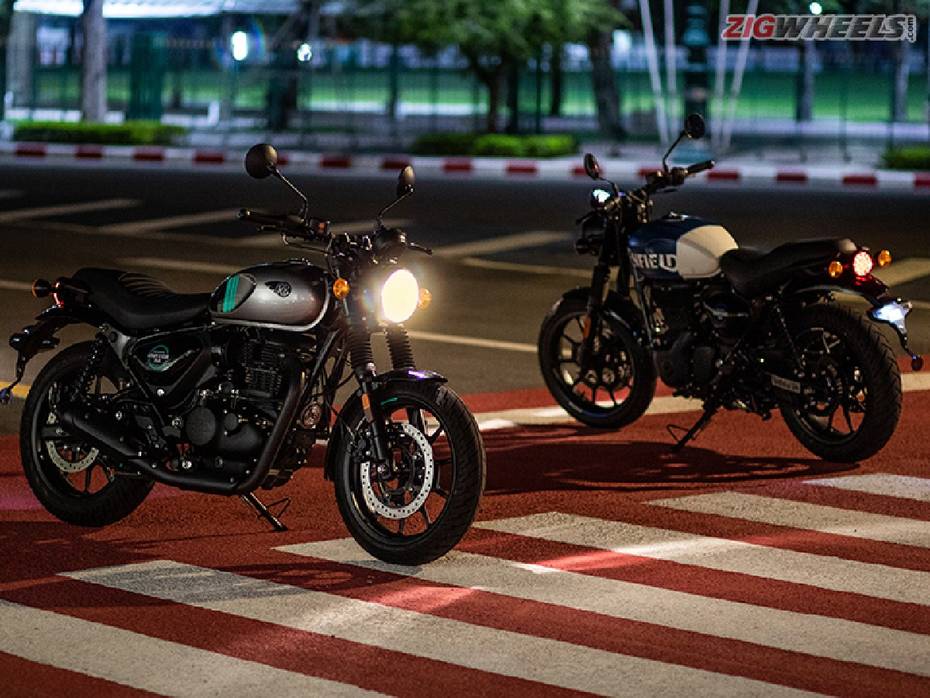
The Retro is the lower variant for the Hunter which will go on sale in India and a few other countries. This variant gets spoked wheels, slimmer tyres, a simpler colour scheme and simpler hardware. For instance, the headlamp misses out on the pilot lamp, the switchgear doesn’t get circular controls, and the instrument cluster is smaller. However, you do get the USB port on this variant too. Further back the grab rail is tubular on the Retro, instead of a split cast-alloy unit; the stop lamp isn’t LED and the turn indicators are the ones from the Himalayan.
|
Retro |
Metro |
|
|
Front Tyre Size |
100/80 - 17 |
110/70 - 17 |
|
Rear Tyre Size |
120/80 - 17 |
140/70 -17 |
|
Tyre Type |
Tube |
Tubeless |
|
Rim Type |
Spoke |
Alloy |
The Retro variant in its all-black colour scheme with the golden pinstripes looked really good in the flesh. The aesthetic misses and the slightly narrower tyres front and rear aren’t deal breakers in our books. However, the Retro misses out on a rear disc brake and gets single-channel ABS only, which is a deal breaker. Whether you choose the Retro or Metro variant, you could glam it up with accessories like a fly-screen, bar-end mirrors, LED turn indicators and a tail tidy. RE has over twenty individual accessories for you to choose from, or you could pick from the Urban or Suburban packs. The former is meant to be a more style-oriented pack, while the latter is meant to be more commute oriented.
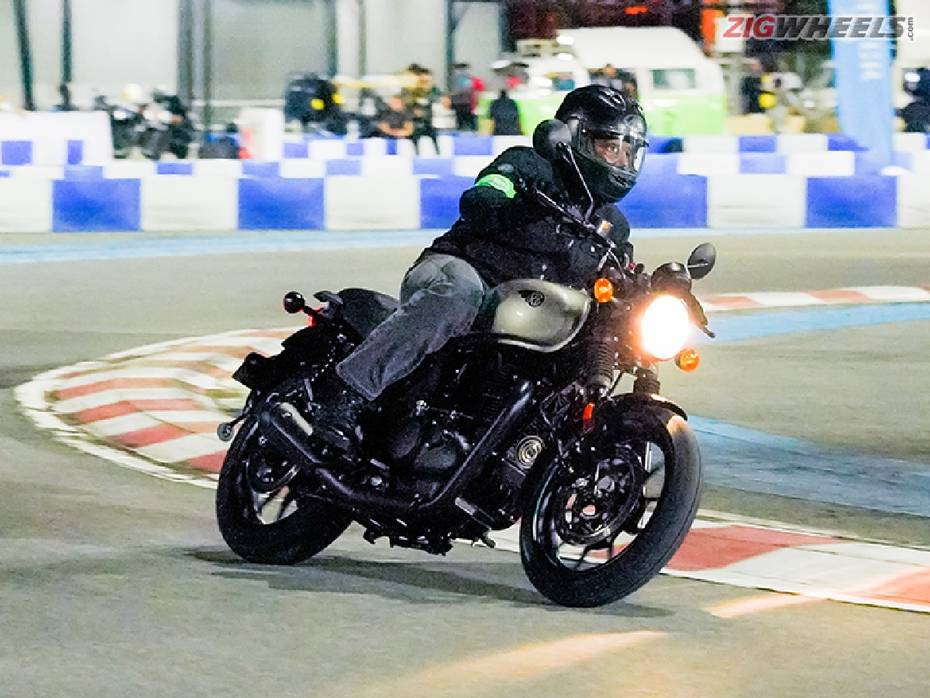
While the Hunter looks light and accessible, the impressive bit is that it feels that way too. Pick it up and off the stand, and the difference will be clear. There are a number of changes responsible for this, the first of which are the 17” wheels.
RE engineers have tweaked the chassis to make it a bit sportier too. Firstly, the footpegs have been pushed about 100mm rearwards–this tips the rider forward slightly. Just as importantly, the lower portion of the cradle isn’t required, the removal of which helps save weight. This RE isn't scared of using plastic either–both its fenders are plastic. So the smaller rims, the plastic and the frame help save some 10-15kgs - but it's still a 180kg motorcycle.
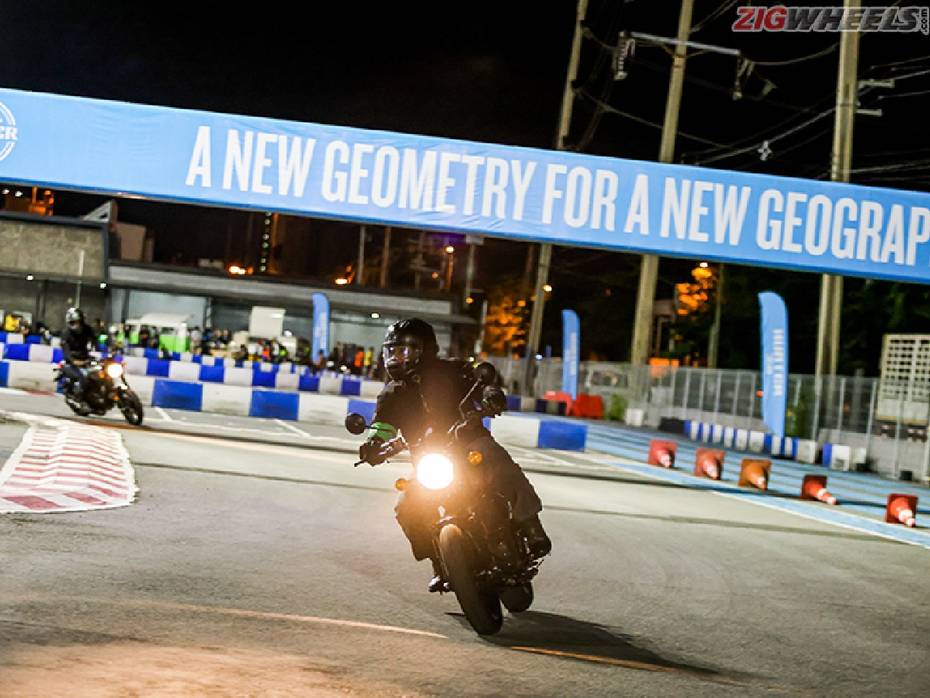
However, when you hit the road, it feels much lighter! The secret to making weight disappear is geometry. Just tweaking a few degrees and a few millimetres at the right spot in the chassis geometry can transform the manners of a motorcycle. The Hunter 350 has many such changes when compared to the Classic; the rake is a degree sharper and the trail is lesser too, which results in a wheelbase that's smaller by 20mm.
|
Hunter |
Classic |
Meteor |
|
|
Rake (in degrees) |
25 |
26 |
26.8 |
|
Trail (in mm) |
96 |
112 |
109 |
|
Wheelbase |
1370 |
1390 |
1400 |
The outcome of these changes is an RE like no other! At low city speeds, it felt nimble and slim, letting you snake your way through bumper-to-bumper traffic. It isn't cumbersome at all! As speeds increased, its willingness to change directions was refreshingly modern. Flickable isn't something I have associated with Enfields, up until now.

The Hunter also eggs you on to ride hard as the seating position has just a hint of commitment to it. The slightly rear-set footpegs and wide bars tip the rider slightly forward. This does encourage you to ride harder and at higher speeds the Hunter can seem a bit frisky when you hustle it around corners. On the whole, this RE feels pretty engaging and willing to ride.
The widest tyres offered on a RE today, a 120-section at the front and a 140-section at the rear, makes the ride a bit more reassuring. Braking hardware is familiar, and so are our observations; there is sufficient bite, but the feel is spongy and immediacy is lacking too.
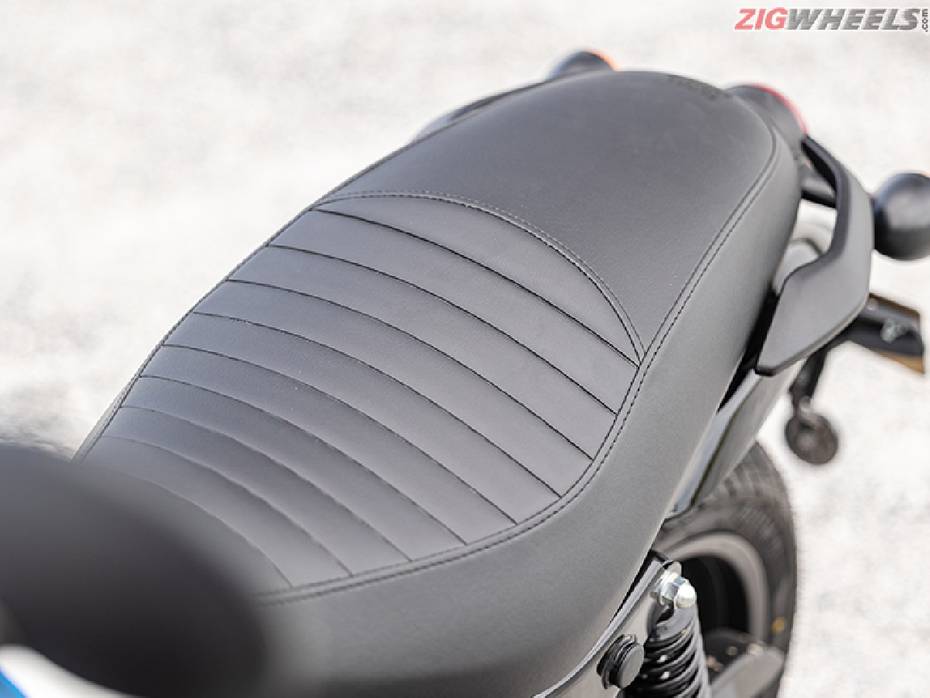
The practicality-minded will appreciate that the Hunter is pretty spacious; so, it doesn't discriminate against taller riders or pillions. As a result, even six-footers will feel at ease in the rider’s seat or when sitting as a pillion. Ride comfort for the most part felt sufficiently controlled, soaking up even larger potholes without tossing you around. However, there was a hint of firmness from the dual shocks at the rear which made some bumps find their way to the rider’s bottom. Keep in mind that we were riding on completely unfamiliar roads at a fast clip. So, we can’t wait to ride it on home turf to examine it further.
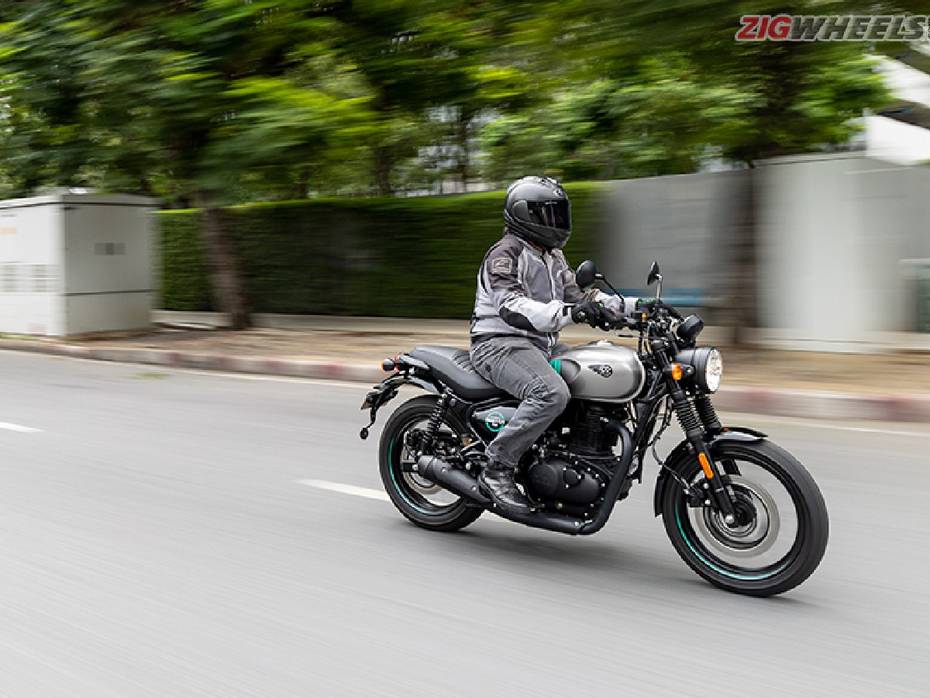
So, is the Hunter more than just the friendliest RE? Could it also be the most youthful and fun RE? The answer is simple, yes! Is it a properly modern experience? Yes. And, no. The hesitation is because of the engine. Sure, it has the same hardware, power and torque figures as the Meteor and Classic, which impressed us. On top of that it has been tuned a bit to better suit this lighter motorcycle too.
|
Hunter |
Classic |
Meteor |
|
|
Power |
20.2bhp @ 6100rpm |
||
|
Torque |
27Nm @ 4000rpm |
||
|
Fuel Efficiency |
36kmpl |
NA |
NA |
However, the youthful attitude of the Hunter’s design combined with the ability and willingness of the chassis makes the mild massaging of the engine seem woefully inadequate. As on the other J platform vehicles, this long-stroke engine doesn't like to be revved, but it feels starkly out of place on this motorcycle. Sure, you can hustle the Hunter, but it isn’t exactly willing.
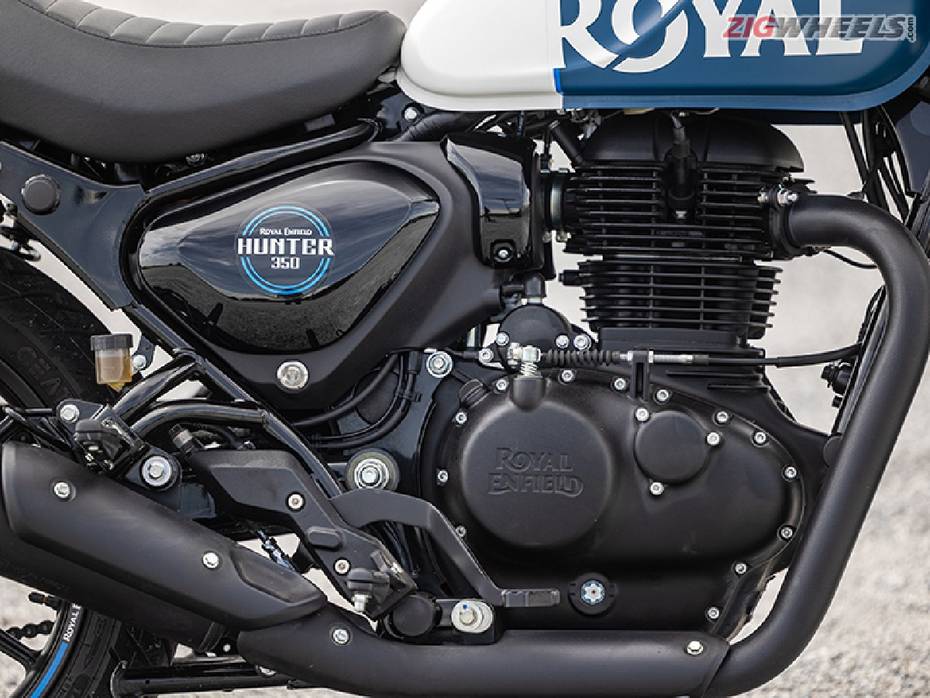
The practicality-minded will also complain that the clutch will feel a bit heavy for stop-go city traffic use. However, if you choose to ride in a relaxed or commuterish fashion the torque from the engine will keep your city rides hassle-free. Highway users will find cruising at 90kmph relaxing, but not exactly invigorating.
This Royal Enfield has a few misses. Given its accessibility focus, its claimed fuel efficiency of 36kmpl may not be a winning factor for those surviving on pocket money. A smaller, modern, punchy and fuel-efficient motor would have been better suited in this regard. Tourers should keep in mind too that the Hunter’s 150mm of ground clearance is 20mm lower than its siblings. Also, its seat feels a bit painful for longer rides, but thankfully a more plush seat is available as an accessory.
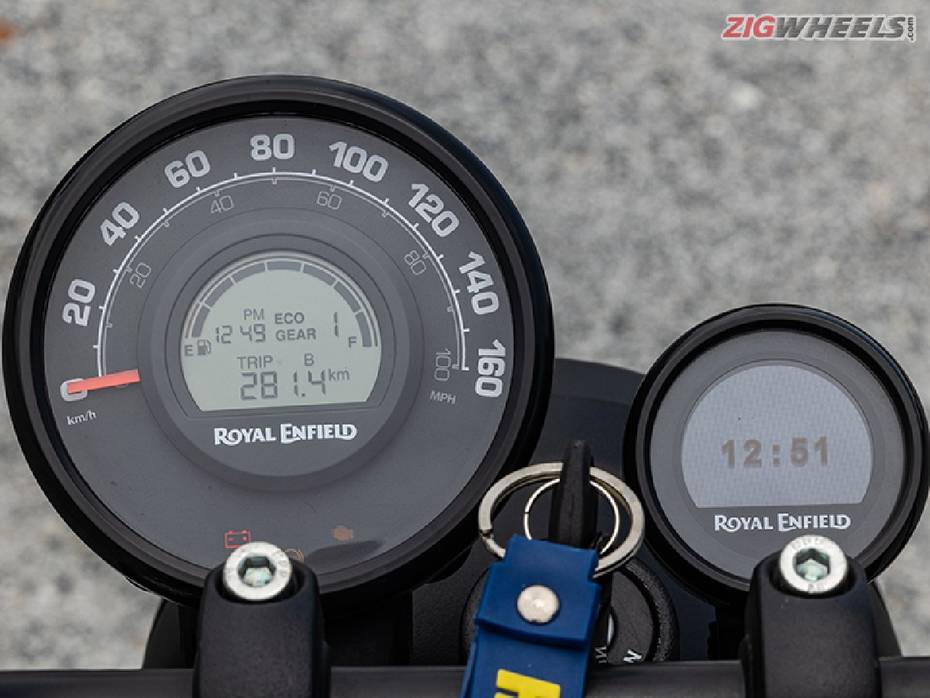
When it comes to features the Hunter skips out on anything that could weigh down the brochure. There are no USD forks, monoshock, LED lamps, ride modes or connectivity features, many of which are offered by TVS’ Ronin while delivering phenomenal value for money too. Also, the fit and finish is still a bit rough at places on the Hunter.

So the Hunter makes for an impressively friendly and modern motorcycle from Royal Enfield. However, on some key fronts, like the engine and performance, its fuel efficiency and feature list it doesn’t feel very modern. However, when you factor in the price, the Hunter regains a lot of lost ground.

|
Price (in Rs) |
Hunter |
TVS Ronin |
Jawa 42 |
|
Single Channel ABS |
1.5 Lakhs |
1.49 Lakhs |
1.67 Lakhs |
|
Dual Channel |
1.69 Lakhs |
1.69 Lakhs |
1.94 Lakhs |
Its prices undercut all of its competition and are on par with the 225cc Ronin and in the process, the Hunter makes up for its misses and cements its promise of being accessible. This makes the Hunter 350 a very potent weapon that will hunt down and bring new members to the Royal Enfield fold.
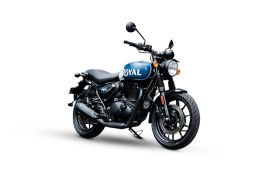

Royal Enfield’s J-platform Bikes: Real-world Performance Compared

Royal Enfield Classic 350: 14,000km Long-Term Review

Royal Enfield Meteor 350 Long-term Review: Change Of Hands At 13,410km

Honda Sunchasers 2022 Ride: Taking The H’Ness To New Heights

Motomax Insta Shine Review: Can It Really Bring A Shine To Your Bike?

Yamaha MT-15 V2 vs TVS Apache RTR 200 4V Comparison Road Test: A...

Yamaha MT-15 Version 2.0 Road Test Review - The Perfect Imperfection

2023 Royal Enfield Bullet First Ride Review: Made Like A Gun, Goes...

TVS Ronin Drift-R School: Flat Tracking Made Fun
 Royal Enfield Classic 350
Royal Enfield Classic 350
 Royal Enfield Meteor 350
Royal Enfield Meteor 350
 Jawa 42
Jawa 42
 Honda Hness CB350
Honda Hness CB350
 Yamaha MT 15 V2.0
Yamaha MT 15 V2.0
India's largest automotive community
 Royal Enfield Classic 350
Rs. 1.93 Lakh
Royal Enfield Classic 350
Rs. 1.93 Lakh
 Royal Enfield Continental GT 650
Rs. 3.19 Lakh
Royal Enfield Continental GT 650
Rs. 3.19 Lakh
 Royal Enfield Bullet 350
Rs. 1.73 Lakh
Royal Enfield Bullet 350
Rs. 1.73 Lakh
 Royal Enfield Meteor
Rs. 2.05 Lakh
Royal Enfield Meteor
Rs. 2.05 Lakh
 Royal Enfield Himalayan 450
Rs. 2.85 Lakh
Royal Enfield Himalayan 450
Rs. 2.85 Lakh